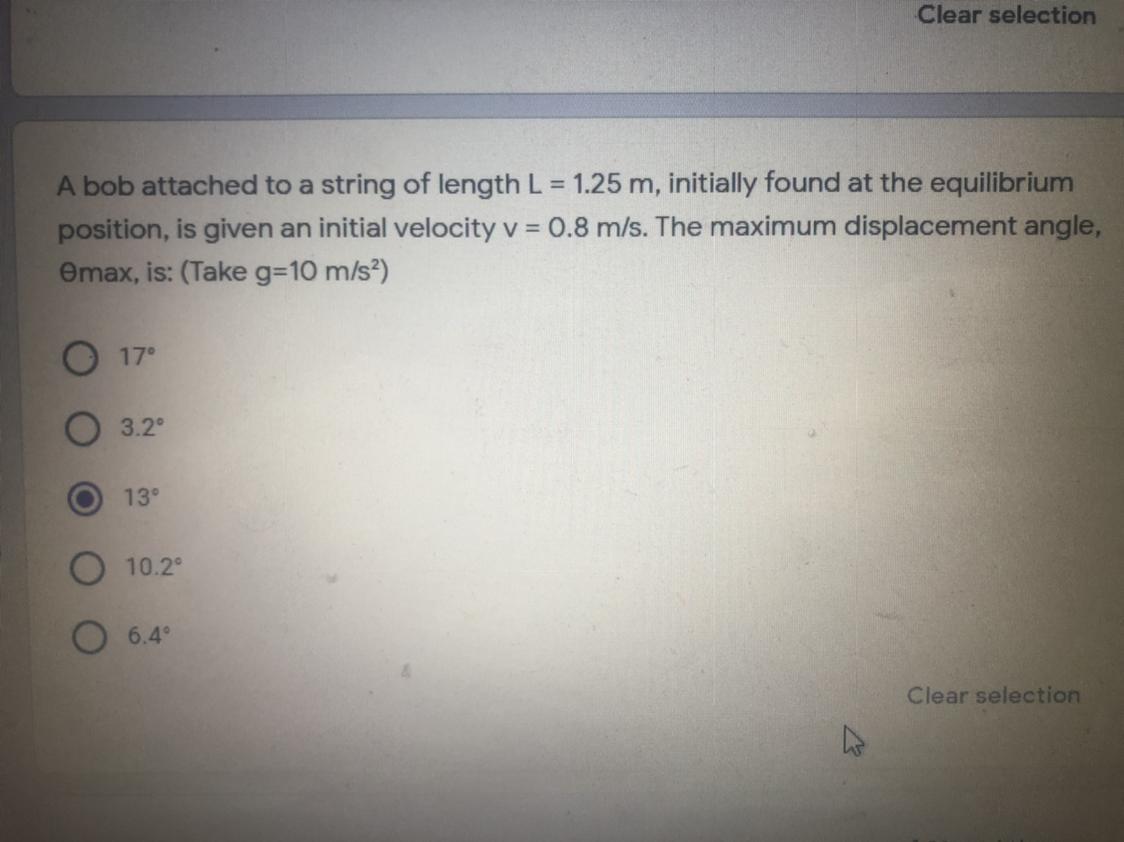A bob attached to a string of length L = 1.25 m, initially found at the equilibrium
position, is given an initial velocity v = 0.8 m/s. The maximum displacement angle,
Omax, is: (Take g=10 m/s)
17
3.2
13
10.2
6.4
Clear selection
A hoh attached to a string of length 2 m is displaced by an angle of 8º and then

Answers
The maximum displacement angle of the bob is 13⁰.
The given parameters;
Length of the pendulum, L = 1.25 mInitial velocity of the bob, v = 0.8 m/sThe maximum displacement of the bob is calculated by applying the principle of conservation of energy;
[tex]P.E = K.E\\\\mgh = \frac{1}{2} mv^2\\\\h = \frac{v^2}{2g} \\\\h = \frac{0.8^2}{2\times 10} \\\\h = 0.032 \ m[/tex]
The maximum displacement angle is calculated as follows;
[tex]cos \theta = \frac{L-h}{L} \\\\cos \theta = \frac{1.25 - 0.032}{1.25} \\\\\cos \theta = \frac{1.218}{1.25} \\\\cos \theta = 0.9744\\\\\theta = cos^{-1}(0.9744)\\\\\theta = 13\ ^0[/tex]
Thus, the maximum displacement angle of the bob is 13⁰.
Learn more here:https://brainly.com/question/13981780
Related Questions
A crane lifts a 10000 N load through a distance of 30mins in 40s calculate work done
Answers
Given,
Force = 10,000 N
Distance = 30 m
Time = 40 s
Work done = force × distance
Work = 10,000 × 30
Work = 300,000 J
______
꧁✿ ᴿᴬᴵᴺᴮᴼᵂˢᴬᴸᵀ2222 ✬꧂
The work done on the object is equal to the power it experiences which is equal to 735 watts.
What is work done?Work done is defined as the product of force applied and the distance over which the force is applied on the object. Work is done on an object when a force is applied to an object and the object is moved through a particular distance.
The time rate of doing work is called as power, which is designated by the symbol P. It is measured in the units of watts, where one watt is equal to one joule energy applied per second time.
Work done on an object is equal to the force (F) multiplied by the distance d in the direction of the force. Where, time interval is Δt.
P = W/Δt = F × d/Δt = m × g × h/Δt = 100 × 9.8 × 30 / 40
Power = 735 watts
The power of the object is 735 watts.
Learn more about Work done here:
https://brainly.com/question/13662169
#SPJ2
You throw a can of cranberry sauce straight up in the air with an initial velocity of 12 m/s. What is the maximum height the baseball reaches above your head.
Answers
Answer:
Δx=7.35m
Explanation:
This is a free fall problem (g= -9.8 m/s²).
Displacement: ? <--- what you're trying to find (max height)
Initial Velocity: 12 m/s
Final Velocity: 0 m/s <-- since the can will land back in your hands
Time: Missing <-- not needed to solve
Acceleration: -9.8 m/s²
The equation that you will use is vf²=vi²+2aΔx
Now plug the information into the equation!
(0m/s)²=(12m/s)²+2(-9.8m/s²)Δx
Multiply the 2 with the acceleration (-9.8m/s²)
(0m/s)²=(12m/s)²-19.6m/s²Δx
Now you need to square the final and initial velocity
0m/s=144m/s-19.6m/s²Δx
Move 144 to the other side of the equal sign
-144m/s=-19.6m/s²Δx
Divide both sides by -19.6m/s²
7.346m=Δx
You can round it to the tenth or hundreth place, up to you!
For this example, I'll round to the hundredth...
Δx=7.35m
I would double check this answer or review it yourself to see if it's correct.
Good luck with your studies!
. Quỹ đạo chuyển động của một vật là
Answers
Answer:
you are very kind Po lang
2. What are the challenges of wind energy that causes decrease in the electrical production?
3. Give two solutions:
1. Modification in the structure of the turbine
2. Modification in the function of the turbine.
4. You must estimate the cost in each solution, and which one is more affordable and efficient for the municipality to go for.
5. You must make sure that there is minimal energy loss.
Answers
Levelized production cost is a big challenge in the production of wind energy.
The main challenge in the production of wind energy is the high production cost. It has to minimize the Levelized Production Cost (LPC) which is the ratio between energy production cost and economic lifetime. This problem can be solved by doing modification in the structure of the turbine as well as we must ensure minimal energy loss.
The modification in the structure can produce more electrical energy and reduce the energy loss also provides more profit to the company so we can conclude that levelized production cost is a big challenge in the production of wind energy.
Learn more: https://brainly.com/question/25543609
How does water temperature affect density?
Answers
An "energy bar" contains 26 ggof carbohydrates.How much energy is this in joules?
Answers
Tommy does 45 Joules of work to push the pencil over 3 meter. How much force did he use?
Answers
Answer:
Work = Force × Distance
Therefore Force = Work/Distance
= 45 joules/3 metres
= 15 newton
Explanation:
Answer:
15
Explanation:
15
What symbols are these?
Answers
Answer:
the bottom one is wollsiegel